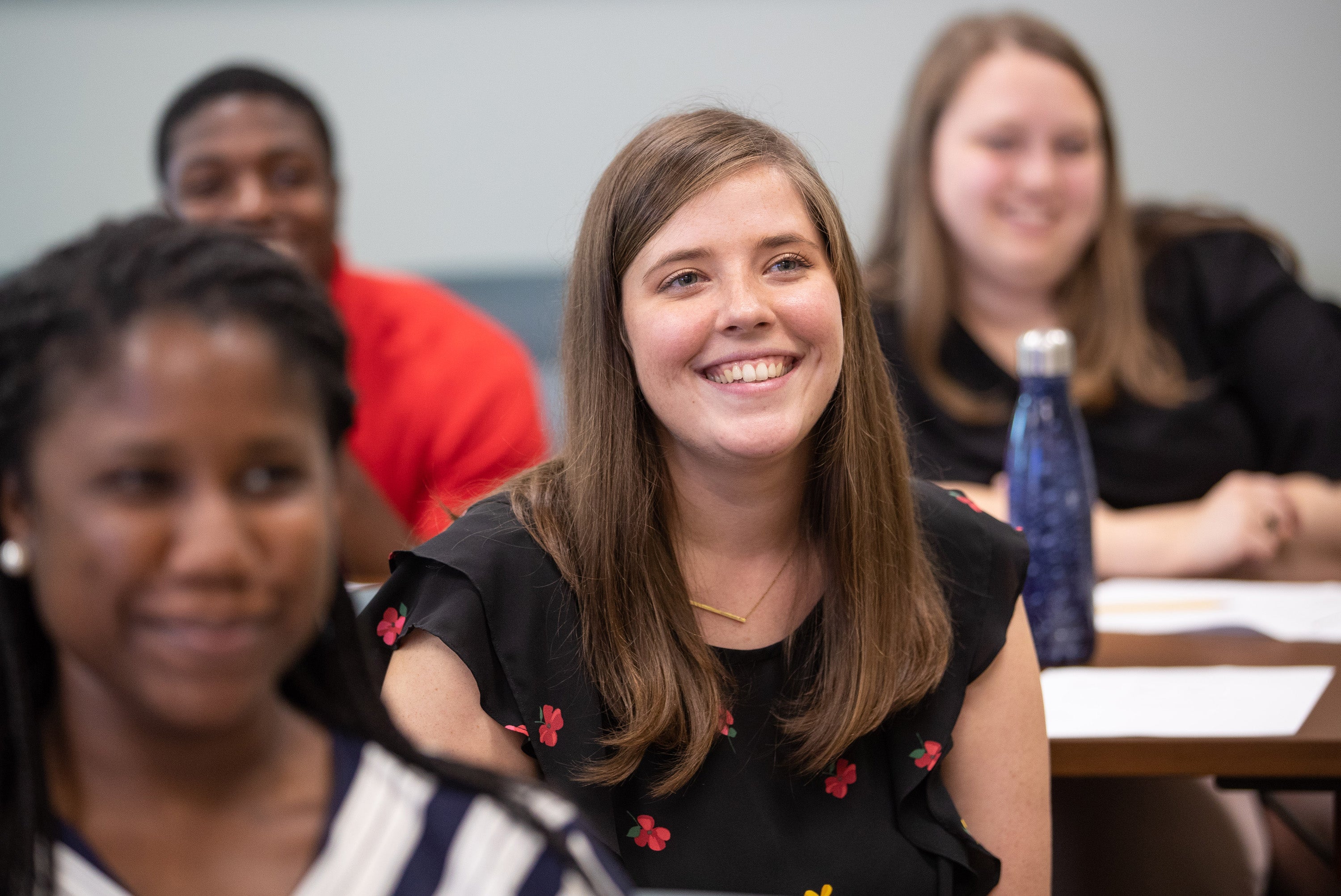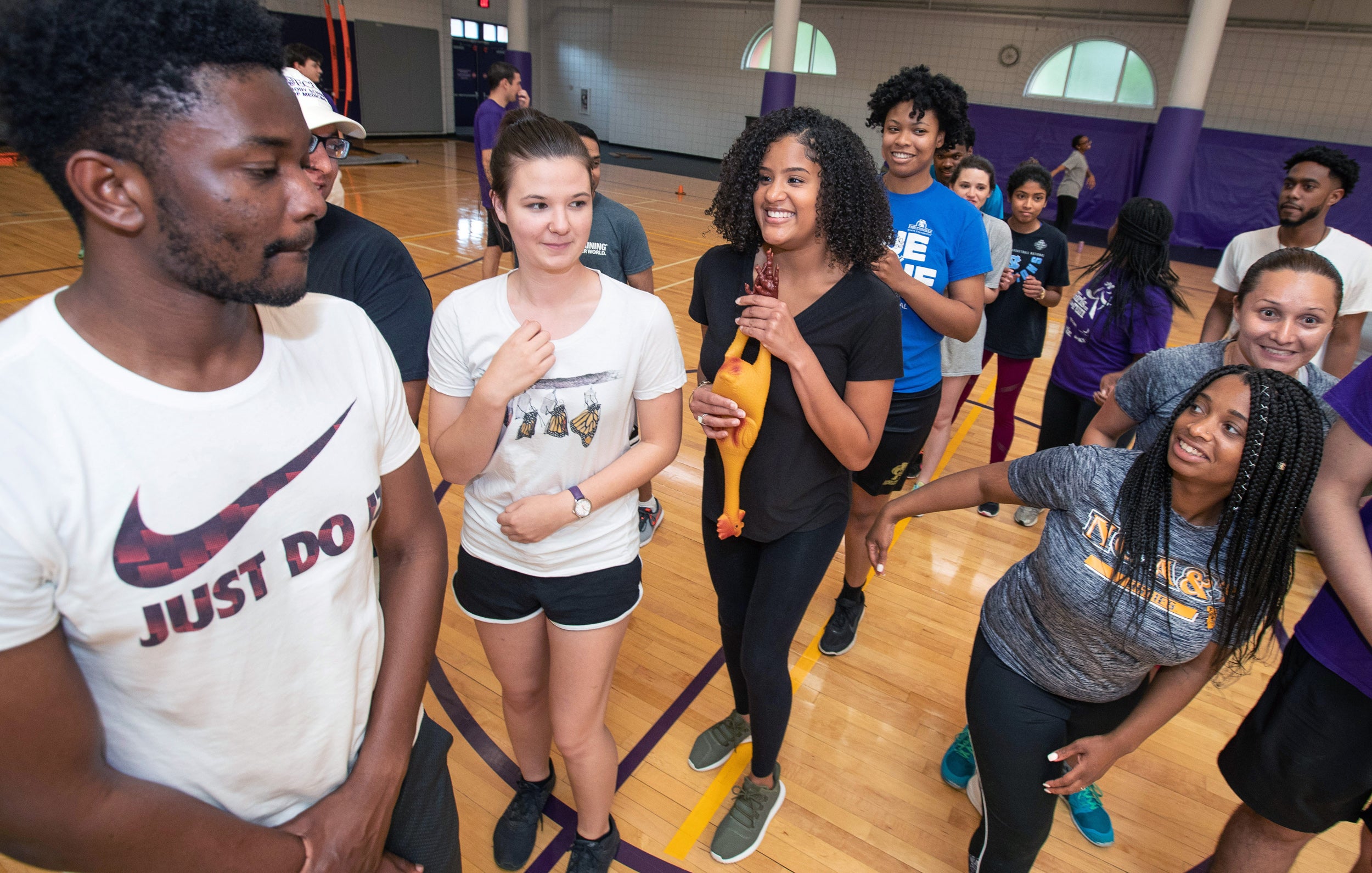Brody offers glimpse of life in medical school
Since her childhood, Melenis Lopez has dreamed of becoming a physician who heals patients in underserved communities and makes an impact on every life she encounters along the way.
Thanks to her experience in the Summer Program for Future Doctors (SPFD), the edges of Lopez’s dream are now more defined.
Lopez and the rest of the 2018 SPFD cohort, made up of students who show interest, potential and promise for careers in medicine, went through an intensive, nearly two-month program at the Brody School of Medicine at East Carolina University, highlighted by course work, team building and hands-on medical school experiences.

Students in the Summer Program for Future Doctors experience course work and class discussions that mirror the first year of medical school. (Photos by Rhett Butler)
“The SPFD program is designed for minorities or disadvantaged students, which is what essentially caught my eye,” said Lopez, a senior majoring in public health studies at ECU. “Through this program, I wanted to learn more about medical school and further my understanding of Brody’s mission.”
Brody’s purpose is to increase the supply of primary-care physicians for the state, improve the health status of eastern North Carolinians and enhance the access of minority and disadvantaged students to a medical education. The SPFD acts as that mission in action.
“SPFD serves as a pipeline program, bringing together promising prospective students from across the state of North Carolina,” said Dr. Richard Ray, director of the SPFD. “While all aspiring medical students are encouraged to apply, the program is particularly interested in students from groups underrepresented in medicine, students from disadvantaged backgrounds and non-traditional students.”

Participants in the Summer Program for Future Doctors enjoy each other’s company at the program’s culminating banquet.
The program focuses on these populations to introduce opportunity and access, but also to be mindful of the patient cross-section that stands to benefit from Brody’s graduates.
“The goal, as it is for the Brody School of Medicine,” Ray said, “is to have a very diverse class that is representative of the patient population that Brody graduates will serve.”
During SPFD, students are immersed in what compares to the life of a first-year medical student based on academic rigor and pace. The students are given the chance to clearly demonstrate their academic readiness for the rigorous curriculum of the preclinical years of medical school and to hone their interpersonal skills and overall professionalism vital to successful medical students and doctors.
Those tests of fortitude and resilience were welcome challenges for Lopez, a first-generation college student, ECU Access Scholar and ECU Ambassador who wants to practice family medicine in areas with shortages of health care professionals and for patients with limited access and ability to afford care.
“It was eye-opening witnessing the tremendous amount of rigorous material that medical students have to conquer in such a short time span,” she said. “Overall, I learned that medical school is for the brave and the tough; however, it is not impossible.”
It takes a team of Brody faculty, staff and students to introduce the SPFD participants to an accurate view of medical school.
“A collaborative group of Brody faculty donate their time for lectures and lab demonstrations,” said Courtney Horns, director of Brody’s Office of Medical Education. “Current medical students work as TAs to assist the SPFD student with their courses, studying, test reviews and any support the student might need.”
The Office of Admissions also provides sessions to help students complete medical school applications as well as practice interview sessions. Eastern Area Health Education Center provides a clinical-skills session where students meet trained standardized patients and give the patients a diagnosis based on their discovery, among other services the participants gain exposure through.
The SPFD program isn’t all course work and clinical experiences; the students participate in team-building exercises and other activities to motivate and challenge them.

Students in the Summer Program for Future Doctors participate in team-building exercises at the Student Recreation Center.
“I also try to add as much fun and excitement into the program as possible, seeing as the students are spending their summer break taking 8 a.m. classes every day for seven weeks,” Horns said. “I want these students to leave this program and either be excited they will be attending Brody in the fall, or they want Brody as their No. 1 pick for medical school when they start the medical application process.”
Since the program began in 1987, SPFD has tallied some notable statistics and success stories, including from recent cohorts.
Brody’s incoming first-year class has 12 students who attended SPFD as non-matriculating students. Thirteen of the 23 non-matriculating students in the 2017 SPFD are now in medical school; several of the others will be applying for the first time this cycle. Seventeen of the 27 non-matriculating students who attended the 2016 SPFD are now in medical school.
“Considering the fact that Brody had nearly 1,100 applications for 86 places this year,” Ray said, “SPFD greatly increases a student’s odds of gaining admission to medical school.”
Lopez’s sights are set on that path as well, now that her SPFD experience cemented her belief that medical school is the right fit for her.
“If there’s one thing this program did, it reassured me that dedicating my life to medicine would make me the happiest person on earth,” she said. “The SPFD program is definitely one of the most challenging things I have ever done. Through my experience, I learned how to get through tough times, ways to maximally utilize resources and most importantly, that I have to tools to be successful.”
-by Spaine Stephens, University Communications